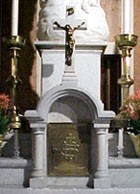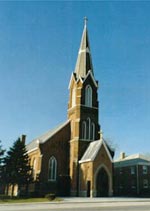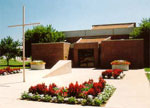 |
|
| The tabernacle at St. Vincent de Paul in Manhattan is left of the main apse. |
Their discontent pivots above all on the placement of the tabernacle, the container in which consecrated hosts are stored after Communion. In the wake of Vatican II, when the altar was turned around so the priest could face the people, the tabernacle in most churches was placed in a side chapel or some off-center location.
Today, some Catholics are clamoring: "Bring it back!" By removing the tabernacle, they say, the church has effectively exiled Jesus. The demand is usually not for a return to pre-Vatican II church design but for placing the tabernacle in a central spot behind the altar or in some other immediately visible place.
To people stumbling across the debate for the first time, it can seem hopelessly arcane. But the tug of war over the tabernacle is fueled by some of the deepest tensions in contemporary Catholicism. "From an architect's point of view, it's very simple," said the University of Notre Dame's Duncan Stroik. "You put out front those things you care about. So we're really asking, 'What do we value?' In the years since the council, we've lost some of our sense of the sacred, and the tabernacle goes right to the center of that."
 |
|
| St. Maurice of Morrisonville, Ill.: Traditional architecture |
David Philippart agrees the placement of the tabernacle is a matter of values but rejects Stroik's conclusion. "We've failed to appropriate the traditional Catholic teaching which Vatican II tried to reemphasize about the many ways Christ is present in the liturgy," said Philippart, a specialist in liturgical architecture for Liturgy Training Publications of Chicago. "Putting the tabernacle back is not going to help."
 |
|
| St. Jude in Joliet, IL: Post-Vatican II architecture |
At the national level, the controversy focuses on a new document on church design being prepared by the U.S. bishops. Called "Domus Dei," or "House of God," the document was discussed for the first time at the November 1999 bishops' meeting and should appear later this year.
Those who carried out Vatican II's liturgical reforms say the tumult over the tabernacle is a poignant reminder that the tradition asserted by their opponents is often skin-deep. Having the tabernacle on the altar is merely one option offered by church history, they say, and far from the norm. The custom of placing the tabernacle on the main altar dates only from the Council of Trent (1545-1563). Rome's major basilicas store the tabernacle in a separate chapel rather than on the main altar.
Critics say the example of the Roman basilicas is a red herring, since most American churches lack the grandeur and scale of their European counterparts. U.S. churches have no tradition of eucharistic chapels--and when they try, the result is often little more than a reconfigured "cry room" or broom closet with a fresh coat of paint.
Critics of moving the tabernacle point to a 1994 New York Times poll, which found that 63% of self-identified Catholics see the consecrated bread and wine at Mass as merely "symbolic reminders" of Christ, rather than his actual body and blood. For those of ages 18-29, a full 70% said the bread and wine were symbols; even 51% of regular Mass-goers called them symbols.
The decision to remove the tabernacle is at least partly responsible for these results, according to Stroik: "There's no question that there is a decline in eucharistic sensibility and in reverence for the liturgy as center of our lives, and the location of the tabernacle is part of that."
Father Andrew Greeley, the well-known novelist and sociologist, disagrees. The charge that Catholic belief in the Real Presence has declined is "right-wing propaganda," he said. The problem with polls, according to Greeley, is that respondents often don't understand the theological baggage carried by words like "symbol" or "real." Thus their answers may express the content of the faith without using its technical vocabulary.
Catholic church design after the council generally emphasized austere interiors and Spartan appointments. The idea was to peel back distractions in order to focus on the altar and the assembly. This approach was enshrined in a 1978 document of the U.S. bishops' Committee on Liturgy titled Environment and Art in Catholic Worship.
For critics, the demise of Environment and Art cannot come too soon. The document "sees a church as merely a tent," Stroik said. "Going into a church should not be like walking into Wal-Mart."
"That's rubbish," said Benedictine Father Aidan Kavanagh, a liturgist at St. Meinrad's Seminary in Indiana and a pioneer in post-Vatican II liturgical renewal. "A lot of that post-Tridentine stuff was cutesy and fluffy, 'good night sweet Jesus' kinds of junk,' he said. "The main liturgical symbol is not supposed to be a plaster angel; it's the altar." Kavanagh said he wasn't defending poorly designed church interiors that "look like somebody's living room." But he insisted that a design that properly reflects the council's call for noble simplicity can "take your breath away." The present draft of Domus Dei expresses a preference for having the tabernacle in a side chapel. During discussion at the November U.S. bishops' meeting, however, most bishops who spoke supported the movement to return it to the center.
The new edition of Domus Dei is likely to drop the preference for a side chapel, though it will not call explicitly for restoring the tabernacle to the center. The debate over the placement of the tabernacle will likely still be fought out at the parish and diocesan level. Philippart said the core challenge is to design the church and celebrate the Mass in such a way that God's closeness shines through. In that light, there are more important considerations than where the tabernacle goes. "If the Mass is being celebrated so poorly that people aren't aware of how Christ becomes present in the Eucharist, the priest can wear the tabernacle around on his head and it's not going to make any difference," he said.

